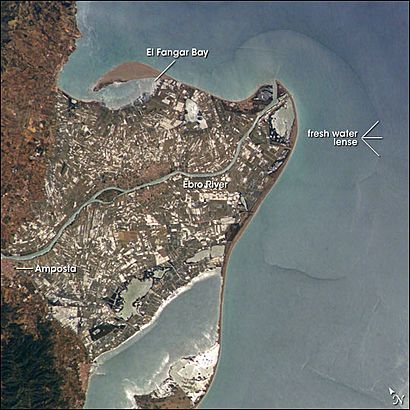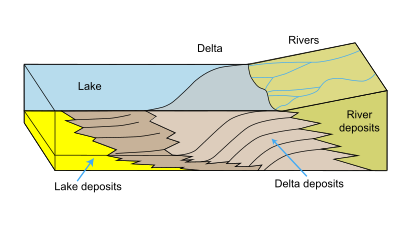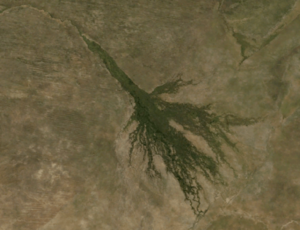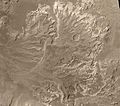River delta facts for kids
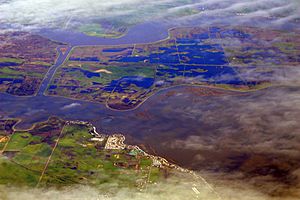
A river delta is a landform shaped like a triangle, created by deposition of sediment that is carried by a river and enters slower-moving or stagnant water. This occurs where a river enters an ocean, sea, estuary, lake, reservoir, or (more rarely) another river that cannot carry away the supplied sediment. It is so named because its triangle shape, resembles the Greek letter Delta.
River deltas are important in human civilization, as they are major agricultural production centers and population centers. They can provide coastline defense and can impact drinking water supply. They are also ecologically important, with different species' assemblages depending on their landscape position.
Contents
Etymology
A river delta is so named because the shape of the Nile Delta looks like the triangular uppercase Greek letter delta.
As a generic term for the landform at the mouth of river, the word delta first appeared in the English-speaking world in the late 18th century, in the work of Edward Gibbon.
Formation
River deltas form when a river carrying sediment reaches a body of water, such as a lake, ocean, or a reservoir. When the flow enters the standing water, it is no longer confined to its channel and expands in width. This flow expansion leads to a decrease in the flow velocity. As a result, sediment drops out of the flow and is deposited as alluvium, which builds up to form the river delta. Over time, this single channel builds a deltaic lobe (such as the bird's-foot of the Mississippi or Ural river deltas), pushing its mouth into the standing water.
Types
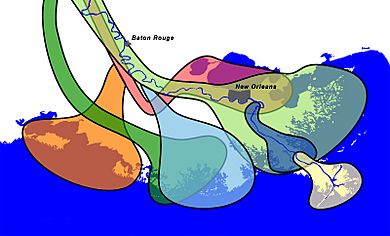
Deltas are typically classified according to the main control on deposition, which is a combination of river, wave, and tidal processes, depending on the strength of each. The other two factors that play a major role are landscape position and the grain size distribution of the source sediment entering the delta from the river.
Fluvial-dominated deltas
Fluvial-dominated deltas are found in areas of low tidal range and low wave energy. The modern Mississippi River delta is a good example of a fluvial-dominated delta. Other fluvial-dominated deltas include the Mackenzie delta and the Alta delta.
Gilbert deltas
A Gilbert delta (named after Grove Karl Gilbert) is a type of fluvial-dominated delta formed from coarse sediments, as opposed to gently-sloping muddy deltas such as that of the Mississippi. For example, a mountain river depositing sediment into a freshwater lake would form this kind of delta. Gilbert himself first described this type of delta on Lake Bonneville in 1885. Elsewhere, similar structures occur, for example, at the mouths of several creeks that flow into Okanagan Lake in British Columbia and forming prominent peninsulas at Naramata, Summerland, and Peachland.
Wave-dominated deltas
In wave dominated deltas, wave-driven sediment transport controls the shape of the delta. With a high wave energy near shore and a steeper slope offshore, waves will make river deltas smoother. Waves can also be responsible for carrying sediments away from the river delta, causing the delta to retreat.
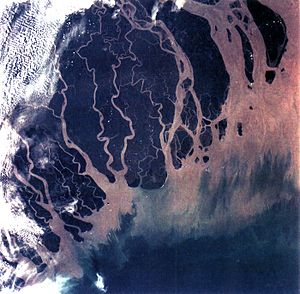
Tide-dominated deltas
Erosion is also an important control in tide-dominated deltas, such as the Ganges Delta. In a tidal delta, new distributaries are formed during times when there is a lot of water around – such as floods or storm surges. These distributaries slowly silt up at a more or less constant rate until they fizzle out.
Tidal freshwater deltas
A tidal freshwater delta is a sedimentary deposit formed at the boundary between an upland stream and an estuary, in the region known as the "subestuary". The origin and evolution of a tidal freshwater delta involves processes that are typical of all deltas as well as processes that are unique to the tidal freshwater setting.Many tidal freshwater deltas that exist today are directly caused by the onset of or changes in historical land use, especially deforestation, intensive agriculture, and urbanization. These ideas are well illustrated by the many tidal freshwater deltas prograding into Chesapeake Bay along the east coastline of the United States. Research has demonstrated that the accumulating sediments in this estuary derive from post-European settlement deforestation, agriculture, and urban development.
Estuaries
Other rivers, particularly those on coasts with significant tidal range, do not form a delta but enter into the sea in the form of an estuary. Notable examples include the Gulf of Saint Lawrence and the Tagus estuary.
Inland deltas
In rare cases the river delta is located inside a large valley and is called an inverted river delta. Sometimes a river divides into multiple branches in an inland area, only to rejoin and continue to the sea. Such an area is called an inland delta, and often occurs on former lake beds. The term was first coined by Alexander von Humboldt for the middle reaches of the Orinoco River, which he visited in 1800. Other prominent examples include the Inner Niger Delta, Peace–Athabasca Delta, the Sacramento–San Joaquin River Delta, and the Sistan delta of Iran. The Danube has one in the valley on the Slovak-Hungarian border between Bratislava and Iža.
In some cases, a river flowing into a flat arid area splits into channels that evaporate as it progresses into the desert. The Okavango Delta in Botswana is one example. See endorrheic basin.
Mega deltas
The generic term mega delta can be used to describe very large Asian river deltas, such as the Yangtze, Pearl, Red, Mekong, Irrawaddy, Ganges-Brahmaputra, and Indus.
Existential threats to deltas
Human activities in both deltas and the river basins upstream of deltas can radically alter delta environments. Upstream land use change such as anti-erosion agricultural practices and hydrological engineering such as dam construction in the basins feeding deltas have reduced river sediment delivery to many deltas in recent decades. This change means that there is less sediment available to maintain delta landforms, and compensate for erosion and sea level rise, causing some deltas to start losing land. Declines in river sediment delivery are projected to continue in the coming decades.
While nearly all deltas have been impacted to some degree by humans, the Nile Delta and Colorado River Delta are some of the most extreme examples of the devastation caused to deltas by damming and diversion of water.
Historical data documents show that during the Roman Empire and Little Ice Age (times where there was considerable anthropogenic pressure), there was significant sediment accumulation in deltas. The industrial revolution has only amplified the impact of humans on delta growth and retreat.
Deltas in the economy
Ancient deltas are a benefit to the economy due to their well sorted sand and gravel. Sand and gravel is often quarried from these old deltas and used in concrete for highways, buildings, sidewalks, and even landscaping. More than 1 billion tons of sand and gravel are produced in the United States alone. Not all sand and gravel quarries are former deltas, but for ones that are, much of the sorting is already done by the power of water.
Urban areas and human habitation tends to locate in lowlands near water access for transportation and sanitation. This makes deltas a common location for civilizations to flourish due to access to flat land for farming, freshwater for sanitation and irrigation, and sea access for trade. Deltas often host extensive industrial and commercial activities as well as agricultural land which are often in conflict. Some of the world's largest regional economies are located on deltas such as the Pearl River Delta, Yangtze River Delta, European Low Countries and the Greater Tokyo Area.
Examples
The Ganges–Brahmaputra Delta, which spans most of Bangladesh and West Bengal, India empties into the Bay of Bengal, is the world's largest delta.
The Selenga River delta in the Russian republic of Buryatia is the largest delta emptying into a body of fresh water, in its case Lake Baikal.
Deltas on Mars
Researchers have found a number of examples of deltas that formed in Martian lakes. Finding deltas is a major sign that Mars once had large amounts of water. Deltas have been found over a wide geographical range. Below are pictures of a few.
See also
 In Spanish: Delta fluvial para niños
In Spanish: Delta fluvial para niños
- Alluvial fan
- Avulsion (river)
- Estuary
- Levee
- Nile Delta
- Regressive delta


